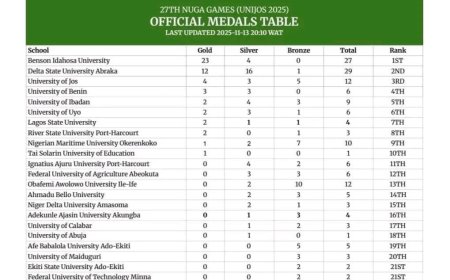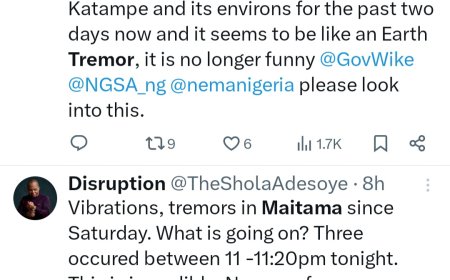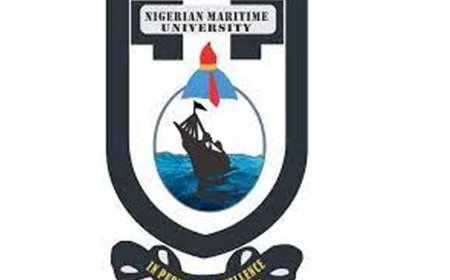Navigating Admission to Nigeria Maritime University (NMU) 2025/2026
The admission process into Nigeria Maritime University (NMU), Okerenkoko, for the 2025/2026 academic session hinges significantly on meeting the stipulated cutoff marks and fulfilling other crucial requirements. As you rightly pointed out, a key prerequisite is that candidates must have selected NMU as their first-choice institution during the Joint Admissions and Matriculation Board (JAMB) registration. Additionally, the timely and accurate uploading of their Ordinary Level (O'Level) results onto the JAMB Central Admission Processing System (CAPS) is mandatory. The final stage involves awaiting the university's admission list, which is determined, in part, by the cutoff marks set for each department. Based on available information and typical practices, these cutoff marks have historically ranged from 150 to 180, contingent on the specific academic program.
Understanding the dynamics of cutoff marks and the overall admission process is vital for prospective students. While the precise cutoff figures for the 2025/2026 session are yet to be officially released by Nigeria Maritime University, we can delve into the factors that influence these benchmarks and provide a comprehensive overview of what candidates should expect.
Admission Prerequisites at Nigeria Maritime University (NMU)
To be eligible for admission into Nigeria Maritime University, candidates must satisfy the following fundamental criteria:
1. JAMB UTME Performance: Candidates must have participated in the Unified Tertiary Matriculation Examination (UTME) conducted by JAMB and achieved a score that meets or exceeds the minimum national cutoff mark. For the 2024/2025 academic year, the general JAMB cutoff for universities in Nigeria hovered around 140 to 180. However, for a specialized institution like NMU and its various departments, the benchmark is likely to be at the higher end of this spectrum or even exceed it for more competitive programs.
2. First Choice Institution: As emphasized, Nigeria Maritime University must be the candidate's first choice of institution during the JAMB registration. This preference often gives candidates an advantage in the admission process, particularly for federal universities in Nigeria.
3. O'Level Qualifications: Applicants are required to possess a minimum of five (5) credit passes in their Senior Secondary School Certificate Examination (SSSCE), which includes examinations conducted by WAEC, NECO, or NABTEB. These credits must include essential subjects such as English Language and Mathematics, along with other subjects relevant to the chosen field of study. Ideally, these credits should be obtained in no more than two sittings to meet the standard requirements of most Nigerian universities.
4. Uploading of O'Level Results: A critical step in the admission process is the accurate and timely uploading of O'Level results onto the JAMB CAPS portal. This allows the university to verify the academic qualifications of the candidates. Failure to upload these results can lead to disqualification, even if a candidate meets the JAMB cutoff mark.
5. No Post-UTME Examination (Subject to Change): As you correctly mentioned, Nigeria Maritime University has not traditionally conducted a Post-UTME screening examination. Admission decisions are primarily based on the candidate's JAMB score and their O'Level results, weighted according to the university's specific criteria and the competitiveness of the program. However, it is crucial for prospective students to stay informed about any potential changes in the university's admission policy, as institutions can sometimes introduce or modify their screening processes.
Determinants of the Cutoff Mark at NMU
The cutoff mark for each program at Nigeria Maritime University is not a static figure but is influenced by several dynamic factors:
1. Overall JAMB Performance of Applicants: The collective performance of candidates who apply to a particular department in NMU through JAMB significantly impacts the cutoff mark. If a department attracts a large pool of high-scoring candidates, the university will likely raise the cutoff to select the most academically proficient individuals for the limited available slots.
2. Popularity and Competitiveness of the Course: Highly sought-after programs within NMU, such as certain engineering disciplines or maritime-specific courses, typically experience a higher number of applicants relative to their admission capacity. This heightened competition invariably leads to higher cutoff marks.
3. Available Admission Quota: Each department within the university has a specific number of students it can admit annually, as dictated by the university's resources and the guidelines set by the National Universities Commission (NUC). When the number of qualified applicants exceeds this quota, the cutoff mark serves as a mechanism to regulate intake and ensure that only the most qualified candidates are admitted.
4. University Admission Policies: The specific admission policies of Nigeria Maritime University, which may include considerations for catchment area, educationally less developed states (ELDS), and other affirmative action criteria, can indirectly influence the final cutoff marks for various programs.
Expected Cutoff Mark Spectrum for 2025/2026
Based on historical data and the information provided, the cutoff marks at Nigeria Maritime University have generally fluctuated between 150 and 180, depending on the specific department. It is reasonable to anticipate a similar range for the 2025/2026 academic session. However, it is crucial to understand that this is an indicative range, and the actual cutoff for a particular course could be higher or lower based on the factors discussed above.
For instance, programs like Marine Engineering, Petroleum and Gas Engineering, Nautical Science, and Maritime Transport and Business Studies, which are often highly competitive due to their specialized nature and career prospects, may likely have cutoff marks at the higher end of this spectrum, possibly 170 or above. On the other hand, emerging or less traditionally popular programs might have cutoff marks closer to the 150 mark.
Academic Programs at Nigeria Maritime University
Nigeria Maritime University offers a focused array of programs tailored to the maritime and related sectors. These typically fall under the following faculties:
Faculty of Maritime Transport and Logistics:
* B.Sc. Nautical Science
* B.Sc. Maritime Transport and Business Studies
* B.Sc. Logistics and Supply Chain Management
* B.Sc. Port Management
Faculty of Maritime Engineering:
* B.Eng. Marine Engineering
* B.Eng. Naval Architecture
* B.Eng. Offshore and Coastal Engineering
* B.Eng. Electrical and Electronics Engineering (with maritime applications)
* B.Eng. Mechanical Engineering (with maritime applications)
Faculty of Marine Environment and Safety:
* B.Sc. Marine Environmental Management and Pollution Control
* B.Sc. Maritime Safety and Security
* B.Sc. Fisheries and Aquaculture
* B.Sc. Oceanography
Prospective candidates should consult the official Nigeria Maritime University website for the most accurate and up-to-date list of accredited programs and their specific admission requirements.
Strategies for Prospective Candidates
For candidates aspiring to gain admission into Nigeria Maritime University for the 2025/2026 academic session, the following strategies are advisable:
1. Aim for a High JAMB Score: Given that the admission process heavily relies on the JAMB score, candidates should strive to achieve a score significantly above the speculated cutoff range of 150-180 to enhance their chances of admission into their desired program.
2. Ensure First Choice Selection: Double-check that Nigeria Maritime University is selected as the first-choice institution during JAMB registration.
3. Secure Required O'Level Credits: Verify that they possess the necessary five credit passes, including English Language and Mathematics, in relevant subjects, ideally obtained in not more than two sittings.
4. Accurate and Timely O'Level Upload: Ensure that their O'Level results are correctly and promptly uploaded onto the JAMB CAPS portal.
5. Stay Informed: Regularly visit the official website of Nigeria Maritime University for the latest announcements regarding admission requirements, cutoff marks (once released), and any potential changes to the admission process.
Conclusion
The cutoff mark for admission into Nigeria Maritime University, Okerenkoko, for the 2025/2026 academic session will be a critical factor in determining successful candidates. While the historical range of 150 to 180 provides a general expectation, the actual marks will depend on the performance of applicants, the popularity of the courses, and the university's admission policies. By ensuring they meet all the stipulated prerequisites, particularly selecting NMU as their first choice and accurately uploading their O'Level results, and by aiming for a competitive JAMB score, prospective students can significantly improve their chances of securing admission into this specialized institution. Continuous engagement with the official NMU website remains the most reliable way to obtain up-to-date and accurate information regarding the admission process.
What's Your Reaction?






























![Meet the Contestants of The Next Big Thing [TNBT]](https://flashupdates.com.ng/uploads/images/202508/image_430x256_688e0cb7c6806.jpg)

































![Breaking News: Nigeria Maritime University swimmers qualifies to represent Nigeria in Germany [10 gold, 9 silver & 6 bronze]](https://flashupdates.com.ng/uploads/images/202504/image_140x98_67f8fd19b3b17.jpg)






